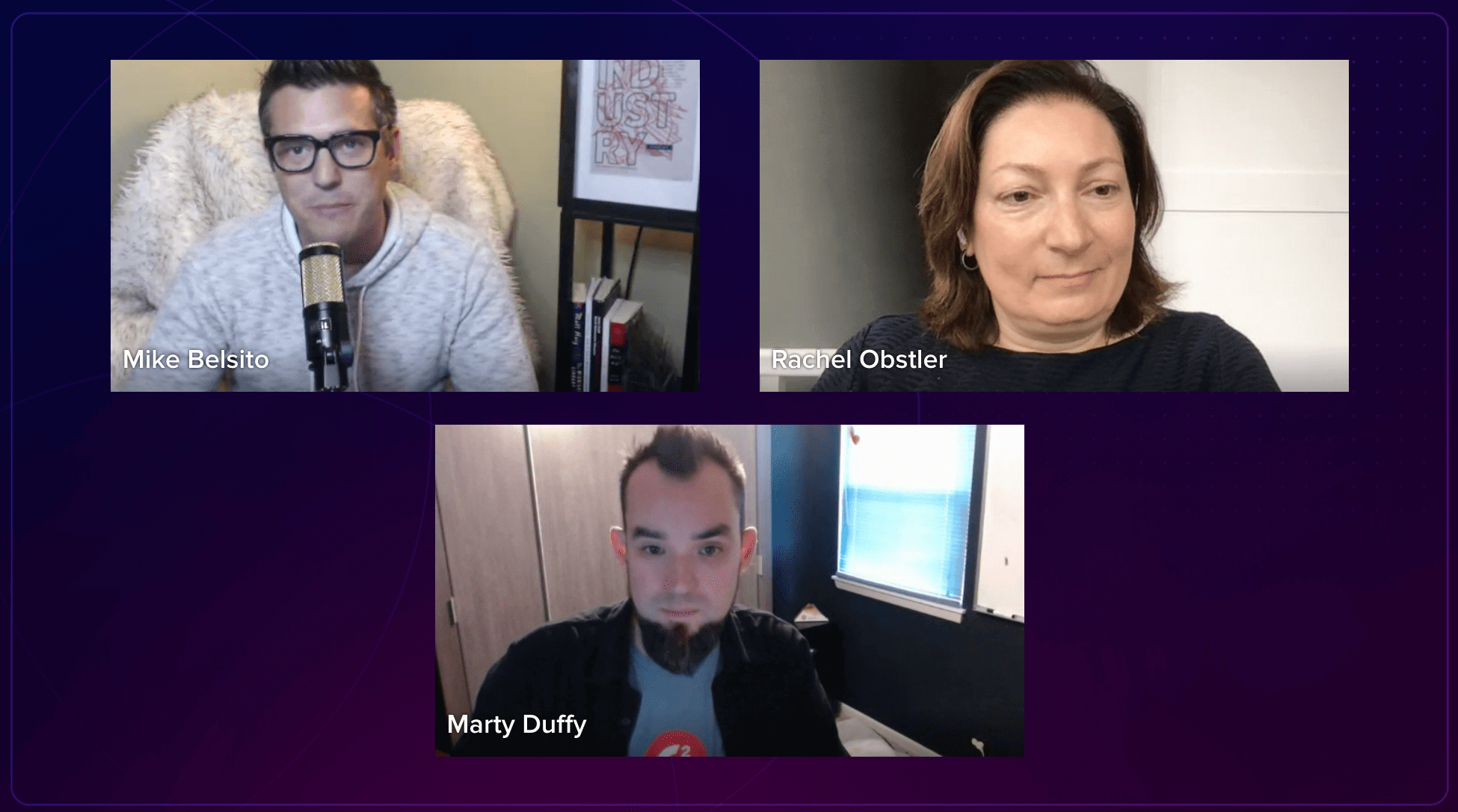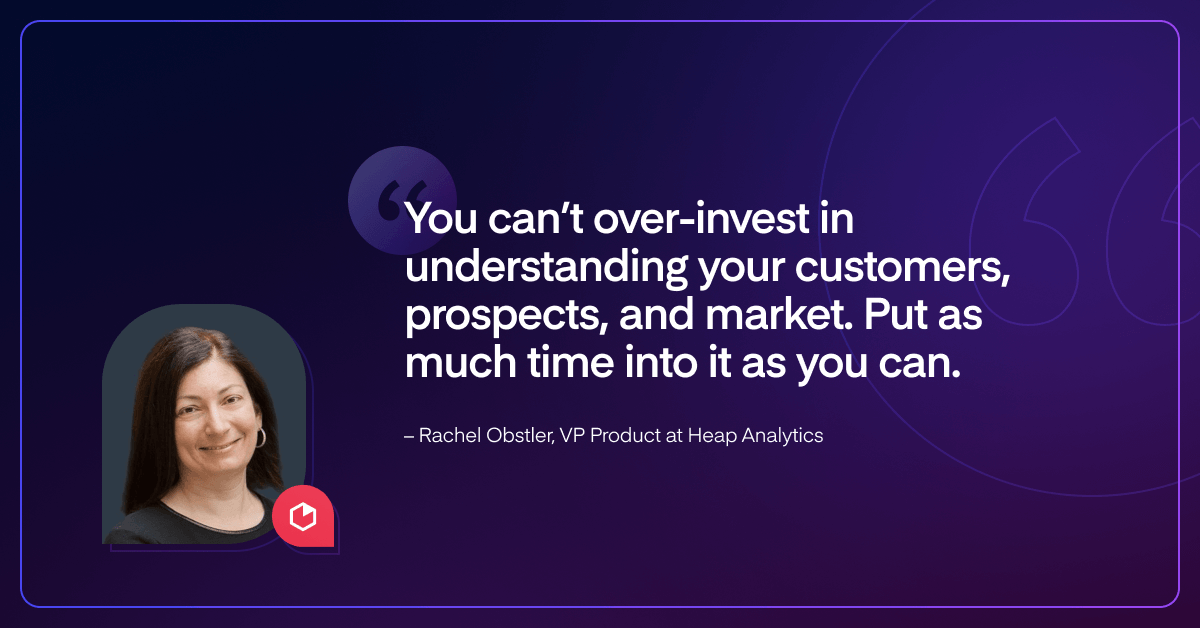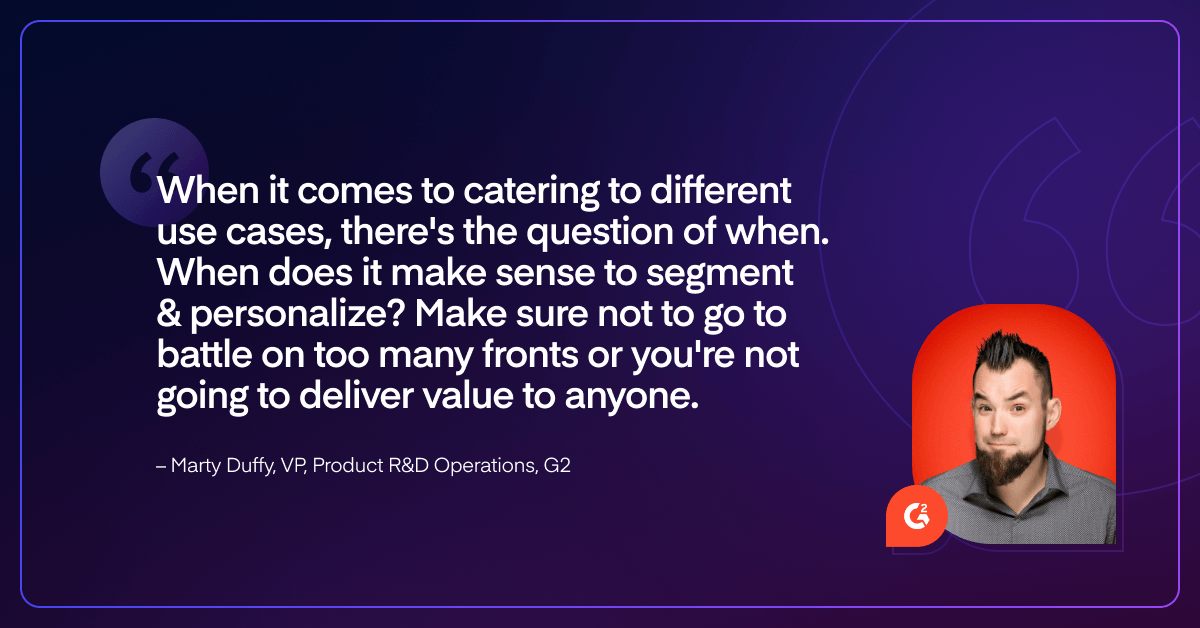Building customer-centric products, processes, and cultures

Most product people agree that customer-centricity is important. After all, the products and features you work so hard to build won’t make any impact if no one uses them. But what does it mean to truly create customer-centric products, processes, and cultures?
During the Product Excellence Summit, Mike Belsito, co-founder of Product Collective, moderated a conversation between Rachel Obstler, VP of Product at Heap Analytics, and Marty Duffy, VP of Product, R&D Operations, at G2. Find a lightly edited version of their conversation below, or view the on-demand recording here.
Mike: Customer-centricity is a word that’s used often, but there’s no standard definition. What does customer-centricity mean to you?
Rachel: I like to put a product-led growth lens on it. The whole idea behind product-led growth is always keeping the end user’s needs in mind. A lot of people like to try and buy software on their own these days. Every interaction you’re having with your users and customers is happening through your product, which means your product needs to be usable, discoverable, and understandable.
Marty: Software is something that’s helping someone achieve a job or do something they might normally be able to do, but doing it better. Customer-centricity is knowing and understanding who your customers are and what that activity is they’re trying to perform and ensuring everything you’re doing is holding true to that.
“Customer-centricity is knowing and understanding who your customers are and what that activity is they’re trying to perform and ensuring everything you’re doing is holding true to that. ”
Mike: How do you create a customer-centric culture throughout your company?
Marty: Understand the company you’re in, the discipline that’s leading out, and look for how you can inject that voice of the customer alongside whoever’s leading out in that instance.
Rachel: I really like the jobs-to-be-done framework. It’s one that we use to get a better sense of what our customers and prospects are trying to accomplish. The concept behind jobs-to-be-done is that people don’t buy your product, they hire your product to solve a problem or to do a job they need to get done.
This framework gets at both what the customer or prospect is trying to accomplish and how they talk about it. It doesn’t only help with what you should be building and what problems you need to be solving, but what words you use when you describe what you’re doing. It’s a great way to align the organization.
Even though it’s important to have self-service, you still have CSM teams, sales teams, and solutions teams. If you can all use the same language and align around those important jobs that are the main problems customers or users are trying to solve, it’s a lot more powerful. You can help your customers be more successful with your product.
“If you can all use the same language and align around those important jobs that are the main problems customers or users are trying to solve, it’s a lot more powerful.”
Mike: How can we best figure out which jobs our customers are “hiring” us for?
Rachel: It is difficult and it takes a certain skill set. And you can’t just look at data. To figure this out, you really need to interview people. We hired an outside firm to help us with this and worked with them to put together a questionnaire and did a whole bunch of targeted interviews. We actually used non-customers to get a broader view of the market. We picked the verticals and roles of people that we wanted to talk to, and we did about two dozen hour-long interviews. It takes a lot of time to set this up, but it’s so worth it because you can never overinvest in learning about your prospects and your market.

Mike: Qualitative data is data, too. You start to see patterns as you do more and more interviews.
Rachel: And you can start to calibrate. We were able to decide which things we wanted to focus on, which things were less important An hour seems like a long amount of time, but with all that you want to learn, it’s actually not that long.
Mike: I want to talk about the idea of the average user. The ability to segment your customers and develop strategies that prioritize a range of needs is a really important part of what it means to be customer-centric. How do you address different use cases?
Marty: It’s critical. Getting back to the idea that our product exists to help someone do something, if someone’s use case is unique or different, you need to understand how different it is and make sure you’re delivering it to them for their value. The key point of focusing on our customers and making sure they’re successful is answering the question of when. When does it make sense to segment? When does it make sense to do that unique personalization?
Make sure you understand the product you’re working on or the feature you’re working on and that you’re hitting your target market. What are your KPIs or success metrics? Once you know you’re doing good for one, then you can go to the next level of personalization for the next persona or the next market. You need to make sure that you don’t try to fight too many battles on too many fronts because then you’re not going to serve your customers well in any of them. Make sure that you’re getting your core stuff, then lean in and understand what’s next.

Mike: Rachel, How do you think about segmentation and personalization?
Rachel: That’s a good question, especially for B2B, because most of the time you have many different personas in a single account. So you need to think about what each of those personas are trying to accomplish.
You have a user who’s using the main functionality of the product, but then when accounts get bigger, you have admins. Making sure the admin has the tools they need to be successful and to minimize the time they need to spend making everyone else successful is important.
In one of my last roles, we had a whole theme around zero admin. That didn’t mean we didn’t work on admin features, it meant we wanted our admins to spend hardly any time on menial tasks so they could focus more on evangelizing the product within the organization and getting more people in the organization to adopt it.
At Heap, we often think of the user as someone who’s trying to find insight and answer questions. And then there are stakeholders. They’re people who may just want to see what other people have found, view dashboards, understand the performance of different features and products, but they don’t necessarily want to do a lot of the work themselves.
You have to think through all of those personas, their needs, and what workflows they need to be successful.
Mike: How do you make sure you’re including customer feedback in discovery? And how do people start doing this if they aren’t already?
Marty: First, make sure you’re actually talking to customers — one-on-one, hour-long conversations. Trying to think through the coordination to make that happen and the questions you need to have a fruitful conversation can feel like a lot.
You can do discovery wrong. You can allot time to discovery but not talk to customers. It sounds stupid simple, but make sure you’re talking to customers.
At G2, we wanted to get crisper on our discovery process before we got to delivery. I had a conversation with my CEO to get the buy-in around the value of doing this — listening to customers to make sure we’re solving the right problems.
I looked around to see who was doing this well and I found Teresa Torres, who does great work with a continuous discovery model. We invested in a “train the trainer” approach. We grabbed one product squad — a product manager, designer, and engineering lead — and we sent them through Teresa Torres’ coaching on continuous discovery. Then they brought it back and trained all our other product teams.
I’m a firm believer in accountability. We created a simple KPI: How many hours are we spending talking to customers? It held us accountable to the organization. We’d share our insights and learnings in the company all-hands and our PRDs.
“We created a simple KPI: How many hours are we spending talking to customers?”
Mike: Product-led growth is a topic that sounds great and the self-serve model is really appealing. How do you create your product for those people who are testing it out for the first time?
Rachel: It’s not just optimization—it’s a whole mindset shift. The move into product-led growth reminds me of when people were shifting from waterfall to agile. It’s not just a different way of doing things—it changes your culture and process. It’s fundamental to the way organizations operate.
Product-led growth is the same thing. How you think about building product, how you go to market with product, how marketing works, how success works, how sales works.
Even if you don’t have a full product-led growth motion, it’s still beneficial to your customer base to have this mindset shift anyway. Even if you can’t fully do self-service with your product — though I highly recommend that, because there’s a set of customers who just prefer it — it is still really useful to have this lens on your product. You want a new user on an existing account to be able to go in and discover and figure things out on their own. Everything in your product should be discoverable, understandable, easy to set up.
“You want a new user on an existing account to be able to go in and discover and figure things out on their own. Everything in your product should be discoverable, understandable, easy to set up. ”
Imagine that every time you launched a new feature, the only way to get customers to use and benefit from it is to get them on the phone with a customer success manager. It’s just not scalable.
Mike: How about delivery? What does customer-centricity look like there?
Marty: This is a bit of a newer learning for me. Our Chief Product Officer here at G2 says that sometimes the launch is the beginning. You need to make sure you’re building room for taking feedback and iteration before you move on to the next thing. Are you empowering your product marketing teams with the right verbiage? Are you empowering your sales teams with training for the sales floor? And building room for feedback in there?
The back-end is just as important as the front-end.
Mike: I’m going to finish with a lightning round. If people walked away from this session with just one takeaway, what would it be?
Rachel: You can’t over-invest in understanding your customer, your prospects, and your market. This is a great example of the challenge of the important vs. the urgent. Getting a better understanding of your customer base is always important, but it’s typically not urgent. It is really crucial that you make time for it. You’re never going to spend too much time on it.
Marty: Grab a Post-it and write down this sentence: How will this help our customers succeed? If you ask that question in any situation, you’ll be fine. If the CEO comes to your desk with an idea, ask, “How will this help our customers succeed?” If somebody’s got that next best feature that they cooked up, ask, “How is this going to help our customer succeed?”
Discover even more great content from the Product Excellence Summit on-demand here.





![The CPO’s Blueprint for Annual Planning: An Opportunity to Drive Change [Part 3]](https://www.productboard.com/wp-content/uploads/2024/11/strategy-blueprint-560x293.png)
